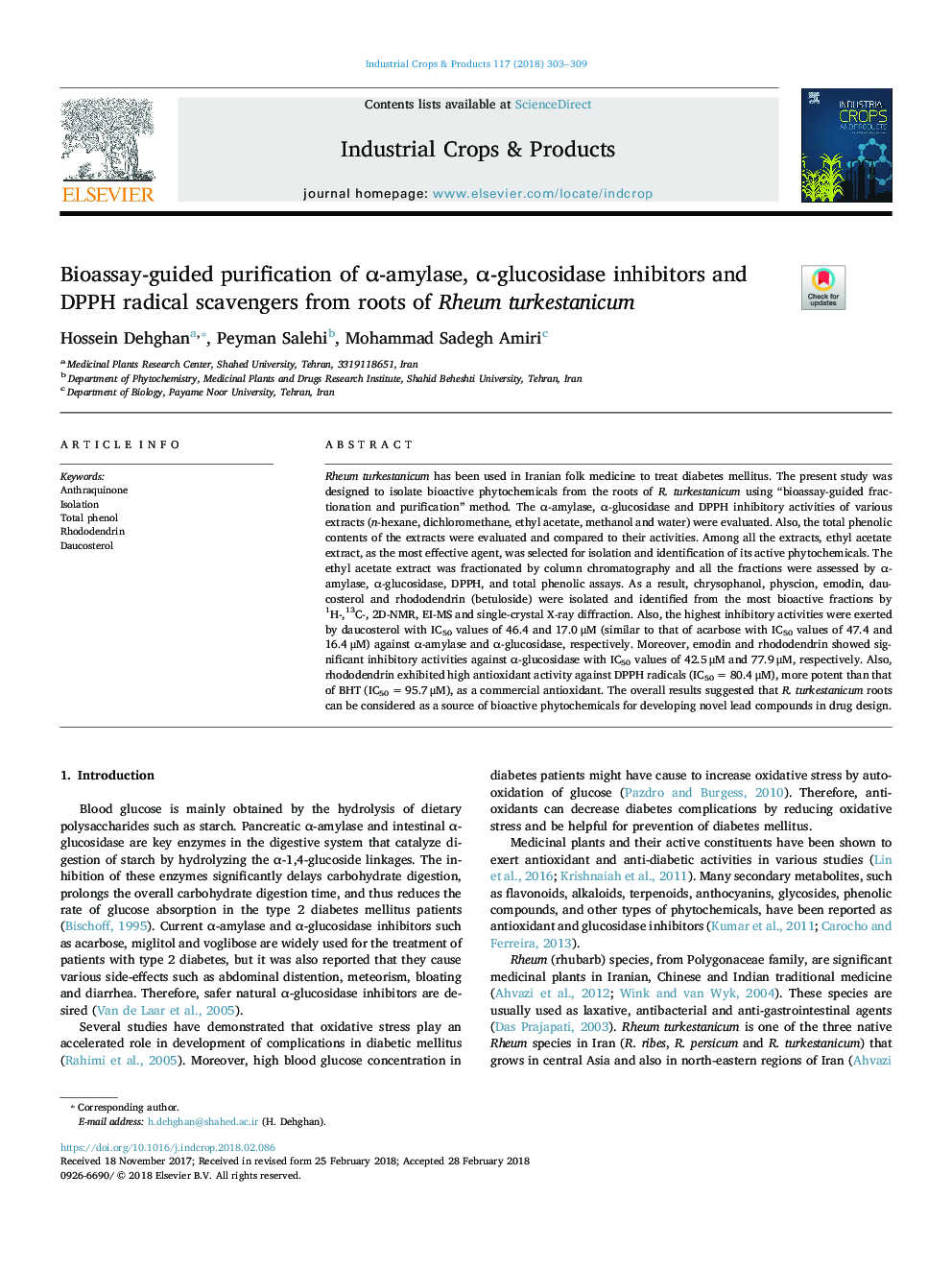| کد مقاله | کد نشریه | سال انتشار | مقاله انگلیسی | نسخه تمام متن |
|---|---|---|---|---|
| 8880163 | 1624793 | 2018 | 7 صفحه PDF | دانلود رایگان |
عنوان انگلیسی مقاله ISI
Bioassay-guided purification of α-amylase, α-glucosidase inhibitors and DPPH radical scavengers from roots of Rheum turkestanicum
دانلود مقاله + سفارش ترجمه
دانلود مقاله ISI انگلیسی
رایگان برای ایرانیان
کلمات کلیدی
موضوعات مرتبط
علوم زیستی و بیوفناوری
علوم کشاورزی و بیولوژیک
علوم زراعت و اصلاح نباتات
پیش نمایش صفحه اول مقاله

چکیده انگلیسی
Rheum turkestanicum has been used in Iranian folk medicine to treat diabetes mellitus. The present study was designed to isolate bioactive phytochemicals from the roots of R. turkestanicum using “bioassay-guided fractionation and purification” method. The α-amylase, α-glucosidase and DPPH inhibitory activities of various extracts (n-hexane, dichloromethane, ethyl acetate, methanol and water) were evaluated. Also, the total phenolic contents of the extracts were evaluated and compared to their activities. Among all the extracts, ethyl acetate extract, as the most effective agent, was selected for isolation and identification of its active phytochemicals. The ethyl acetate extract was fractionated by column chromatography and all the fractions were assessed by α-amylase, α-glucosidase, DPPH, and total phenolic assays. As a result, chrysophanol, physcion, emodin, daucosterol and rhododendrin (betuloside) were isolated and identified from the most bioactive fractions by 1H-,13C-, 2D-NMR, EI-MS and single-crystal X-ray diffraction. Also, the highest inhibitory activities were exerted by daucosterol with IC50 values of 46.4 and 17.0â¯Î¼M (similar to that of acarbose with IC50 values of 47.4 and 16.4â¯Î¼M) against α-amylase and α-glucosidase, respectively. Moreover, emodin and rhododendrin showed significant inhibitory activities against α-glucosidase with IC50 values of 42.5â¯Î¼M and 77.9â¯Î¼M, respectively. Also, rhododendrin exhibited high antioxidant activity against DPPH radicals (IC50â¯=â¯80.4â¯Î¼M), more potent than that of BHT (IC50â¯=â¯95.7â¯Î¼M), as a commercial antioxidant. The overall results suggested that R. turkestanicum roots can be considered as a source of bioactive phytochemicals for developing novel lead compounds in drug design.
ناشر
Database: Elsevier - ScienceDirect (ساینس دایرکت)
Journal: Industrial Crops and Products - Volume 117, July 2018, Pages 303-309
Journal: Industrial Crops and Products - Volume 117, July 2018, Pages 303-309
نویسندگان
Hossein Dehghan, Peyman Salehi, Mohammad Sadegh Amiri,